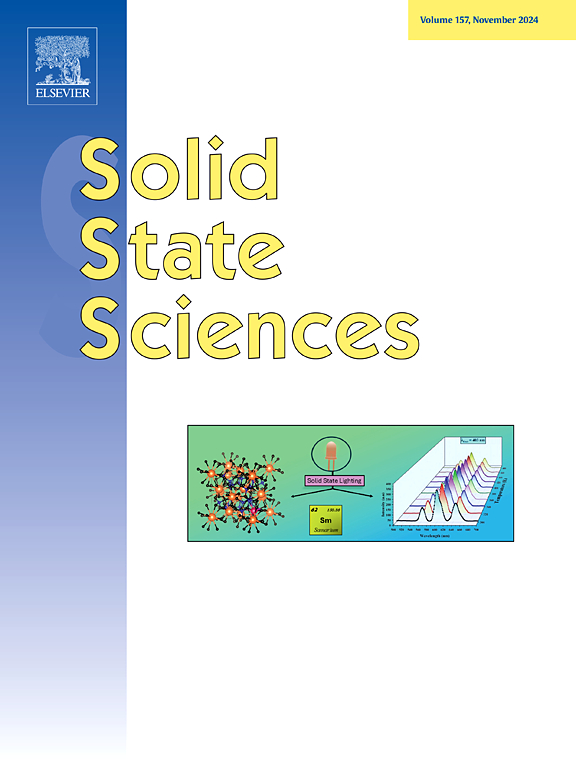Cu2V4O11 nanorods: Inherent peroxidase catalytic activity and application in colorimetric detection of hydrogen peroxide and glucose
IF 3.4
3区 化学
Q2 CHEMISTRY, INORGANIC & NUCLEAR
引用次数: 0
Abstract
In this work, novel Cu2V4O11 nanorods (CVNRs) were meticulously synthesized employing an exquisite one-pot hydrothermal technique, thereby endowed with an inherent peroxidase-like prowess capable of catalyzing the oxidation of 3,3′,5,5′-tetramethylbenzidine (TMB) to produce a blue color reaction in the presence of H2O2. Kinetic examinations revealed that CVNRs exhibited a 3.36-fold increased affinity for TMB in comparison to the natural enzyme horseradish peroxidase, and the catalytic response derived from CVNRs adhered to a ping-pong mechanism. Free radical trapping experiments corroborated the pivotal role of ·O2− radicals in establishing the dominant oxidant for TMB oxidation. Hence, a sensitive visual assessment platform, grounded in CVNRs, was engineered for the detection of H2O2 and glucose. The limit of detection for H2O2 and glucose were 0.054 μM and 2.24 μM, respectively, and the detection ranges were 1–50 μM and 10–75 μM, respectively. Most notably, the visual platform harbored exceptional stability, selectivity, and anti-interference capabilities. This research not only bestows upon CVNRs an extraordinary capability to discern H2O2 and glucose within practical samples, but also expands the realm of application for CVNRs in the domains of environmental preservation, forensic science and biomedical diagnosis.

Cu2V4O11纳米棒:固有过氧化物酶催化活性及其在过氧化氢和葡萄糖比色检测中的应用
在这项工作中,采用一锅水热技术精心合成了新型Cu2V4O11纳米棒(cnvrs),从而赋予其固有的过氧化物酶能力,能够催化3,3 ',5,5 ' -四甲基联苯胺(TMB)在H2O2存在下氧化产生蓝色反应。动力学测试表明,与天然酶辣根过氧化物酶相比,CVNRs对TMB的亲和力增加了3.36倍,并且CVNRs的催化反应遵循乒乓机制。自由基捕获实验证实了·O2−自由基在建立TMB氧化优势氧化剂中的关键作用。因此,我们设计了一个基于CVNRs的灵敏的视觉评估平台,用于检测H2O2和葡萄糖。对H2O2和葡萄糖的检出限分别为0.054 μM和2.24 μM,检出范围分别为1 ~ 50 μM和10 ~ 75 μM。最值得注意的是,可视化平台具有卓越的稳定性、选择性和抗干扰能力。本研究不仅赋予了CVNRs在实际样品中识别H2O2和葡萄糖的非凡能力,而且扩大了CVNRs在环境保护、法医学和生物医学诊断领域的应用领域。
本文章由计算机程序翻译,如有差异,请以英文原文为准。
求助全文
约1分钟内获得全文
求助全文
来源期刊

Solid State Sciences
化学-无机化学与核化学
CiteScore
6.60
自引率
2.90%
发文量
214
审稿时长
27 days
期刊介绍:
Solid State Sciences is the journal for researchers from the broad solid state chemistry and physics community. It publishes key articles on all aspects of solid state synthesis, structure-property relationships, theory and functionalities, in relation with experiments.
Key topics for stand-alone papers and special issues:
-Novel ways of synthesis, inorganic functional materials, including porous and glassy materials, hybrid organic-inorganic compounds and nanomaterials
-Physical properties, emphasizing but not limited to the electrical, magnetical and optical features
-Materials related to information technology and energy and environmental sciences.
The journal publishes feature articles from experts in the field upon invitation.
Solid State Sciences - your gateway to energy-related materials.
 求助内容:
求助内容: 应助结果提醒方式:
应助结果提醒方式:


